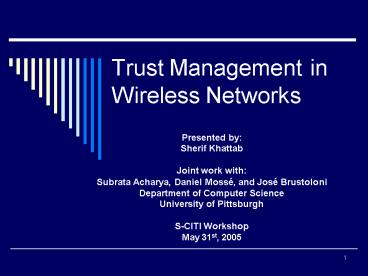Trust Management in Wireless Networks - PowerPoint PPT Presentation
1 / 23
Title:
Trust Management in Wireless Networks
Description:
RUSH ... RUSH. No problem. BLOCK. Delays the process of injecting replies ... RUSH. Since there is no flooding prevents a sub tree from getting election result ... – PowerPoint PPT presentation
Number of Views:357
Avg rating:3.0/5.0
Title: Trust Management in Wireless Networks
1
Trust Management in Wireless Networks
- Presented by
- Sherif Khattab
- Joint work with
- Subrata Acharya, Daniel Mossé, and José
Brustoloni - Department of Computer Science
- University of Pittsburgh
- S-CITI Workshop
- May 31st, 2005
2
Trust Theory
- Socio-cognitive model from T3 Group
- Cognitive agent X trust in agent Y is the result
of a complex mental attitude of X towards Y about
an action/behavior A relative to some result/goal
G. - X decides to delegate A to Y according to
- Beliefs/expectations
- Internal
- external
- Risk analysis
- Trust environment
3
Trust Theory (contd.)
Rely upon Y
4
Trust Theory (contd.)
- Sources of trust
- Direct experience
- Reasoning
- e.g., categorization
- Reputation
5
Challenges in Wireless Networks
- Resource constrained
- PKI for Wireless Sensor Networks is difficult
- Nodes can be compromised
- Efficient and scalable revocation
- Decentralized operation
- Dynamic topology
- Mobility
- intermittent connectivity
- Shared medium
- No point-to-point relationships
6
Example Scenario Leader Election
- Necessary for group communication and management
in distributed wireless networks - key distribution
- route coordination
- sensor co-ordination
- general control
- Secure leader election essential
7
AEFA (Asynchronous Extrema-Finding Algorithm)
Election Ack Probe/Reply Child
Beacon
Support for network partition/merge
8
Secure AEFA
- PKI
- public/private key pair
- Two certificates signed by
- Trust Authority (long-term)
- Group Authority (short-term)
- Exception messages
- If wrong leader detected
9
Our approach
- Security Analysis
- For each message
- Inject/Alter
- Delay (block)
- Rush
- Damage
- Extra overhead
- No/wrong leader
10
Our Approach (contd.)
- Multi-Path Routing
- Trust instead of heavy-weight PKI
11
Methodology
- NS-2 Simulation
- Attack
- message blocking
- Compared Schemes
- Vanilla AEFA implemented by Chris and Brian
(Prof. Brustolonis students) - Secure AEFA (with exception messages)
- Multi-path AEFA
- Metrics
- Energy consumption
- Vulnerability Period ( of time there is no/wrong
leader)
12
Summary
- Design and use of a trust model is necessary
- Encryption not enough (e.g., compromised nodes)
- Encryption cannot be afforded
- Address the vulnerabilities of a leader election
algorithm - Modeling the attacks
- Multi-path routing
13
References
- T3 group http//www.istc.cnr.it/T3/index.html
- AEFA
- Sudarshan Vasudevan, Jim Kurose and Don Towsley.
Design and Analysis of a Leader Election
Algorithm for Mobile, Ad Hoc Networks, ICNP
2004 - Sudarshan Vasudevan, Brian DeCleene, Neil
Immerman, Jim Kurose and Don Towsley. Secure
Leader Election Algorithms for Wireless Ad Hoc
Networks, DISCEX 2003
14
- Questions ?
15
Trust Theory
- An approach to specify and interpret security
policies, credentials, relationships which allow
direct authorization of security-critical
actions. - Key Trust metrics are
- Predictability
- Value Exchange
- Delayed Reciprocity
- Exposed Vulnerability
16
Trust Theory in Security
- A basic concept of Security is the ability of
parties to trust one another. - This amounts to the ability to rely on the
Availability of the trusted party - The Integrity of the information provided by
the trusted party - The Confidentiality of sensitive information
17
Characteristics of Wireless Networks
- Limited radio spectrum
- Shared Medium (collisions)
- Limited energy available at the nodes
- Limited computation power
- Limited storage memory
- Unreliable network connectivity
- Dynamic topology
- Need to enforce fairness
18
Vulnerabilities of the Present Approach
ELECTION
19
Contd
ACK (Not child / Value)
20
Contd
Probe / Reply
21
Contd
Leader (Result, Merging)
22
Contd
BEACON
23
Contd
HELLO































